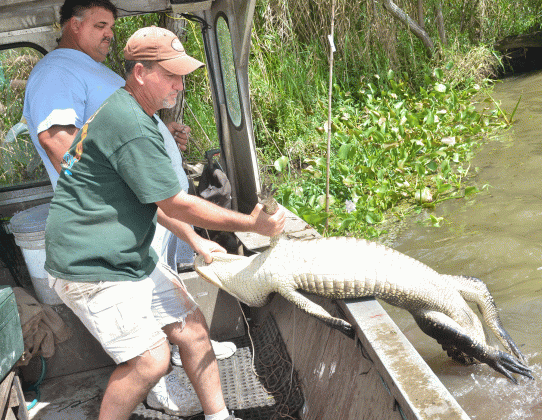
Zachary Fitzgerald
Sidney “Peanut” Michel, left, helps Allen Gros pull in an alligator they harvested during the 2013 season. (The Daily Review File Photo)
Alligator hunters in the area have begun the month-long rush to fill their tags, but officials say fewer hunters will be hitting the swamps this season. A sharp decline in demand for alligator hides has likely caused a severe drop in prices.
The Louisiana Department of Wildlife and Fisheries divides the state into an east zone and west zone for alligator hunting season. The east season began Aug. 30. The west season started Wednesday. Each season lasts 30 days, according to the department’s website.
In St. Mary Parish, the area east of the Atchafalaya River or east of the East Atchafalaya Basin Levee is included in the east zone while west of the river or basin levee is in the west zone.
Alligator hunter Sidney “Peanut” Michel of Morgan City baited his alligator traps Tuesday and planned to begin hunting Wednesday.
Michel expects prices to be extremely low for alligator skin. There are many alligator hides left over from 2016 that haven’t sold. The economic downturn is likely to blame for the lack of market alligator skin, he said.
In 21 years of hunting alligators, this year is the lowest prices he’s seen, Michel said. This year, hunters are getting two prices for alligators by the foot, $6 per foot for 6-foot to 7-foot gators and $10 per foot for alligators 8 feet and over, he said.
Wildlife and Fisheries Alligator Program Manager Edmond Mouton said the low prices are going to cause a dramatic decrease in the amount of people hunting alligators this season. Average overall prices per foot were about $17 in 2016 compared to the 2015 price of $23.50.
During the worldwide economic recession of 2009, the demand for alligator meat and hides was severely depressed with an average price of $7.50 per foot, Mouton said. About 9,000 alligators were harvested that year. The 2017 season could look somewhat similar to the 2009 season, he said.
An average season sees about 35,000 alligators harvested.
There’s still a decent demand for alligator meat, but not enough to provide much overall demand for alligators, Michel said.
Markets are mainly going to pay hunters just for the alligator meat because of the low demand for the skin, Michel said. Michel sells his alligators to Johnny’s Seafood in Berwick to be processed.
Michel hunts in the marshes south of Berwick and toward Shell Island Bayou on both private and public lands.
A resident alligator hunter must either own land or have permission to hunt alligators on land that is classified as wetland habitat in order to qualify for alligator harvest tags, the website says. Michel has enough tags to harvest about 200 alligators during the season, though he’s had nearly 300 tags in previous years.
Wildlife and Fisheries issues harvest tags for property containing sufficient alligator habitat capable of sustaining an alligator harvest. Alligator hunters apply for alligator tags prior to the season, according to the website.
Residents not possessing or having permission to harvest alligators on private lands may be able to harvest alligators on public lands or lakes, the website says.
There are public lands and lakes available for alligator harvest opportunities. These public lands and lakes are managed by many different entities ranging from local parish governments to federal governmental agencies. Wildlife and Fisheries’ officials use bidding and lotteries to select alligator hunters to hunt on these lands, the website says.
The lottery alligator harvest program provides the opportunity for over 300 resident alligator hunters to harvest about 800 alligators on almost 40 wildlife management areas and public lakes located throughout the state, according to the website.
